Vicki thinks I’m crazy to make fresh pasta when dried pasta is cheap and readily available. Even “fresh” pasta lives at the grocery store. I DO like dry pasta for many applications, but fresh pasta has a different texture that I crave from time to time. Grocery store fresh pasta always makes me think of plastic. Besides, you all know I love to play with my food. It’s pretty hard to experiment with ravioli if you don’t make your own pasta.
I make fresh pasta once per term with my older students. We all make a single batch of dough, and since it needs a significant rest, I have a big rested batch pre-made for the students to roll through the pasta machines, culminating in a Fettuccini Alfredo feast. It’s a hit, even though I don’t think they rush home to make their own.
As you can imagine, I have taken some time to experiment in order to guarantee success for my students. You can make pasta with plain ordinary all purpose flour, or you can go a little bit up-town and make it with a combination of flour and semolina, a hard-wheat product with a coarser texture than regular flour. Having done both, I can vouch for the effectiveness of using semolina.
Then, of course, I got to thinking about my gluten-free friends (you know who you are), who might be somewhat dissatisfied with the brown rice dried pasta they have encountered at the supermarket – I certainly have been. The only commercial dried product I like contains corn flour, so the search and the experimentation began!
Some folks out there may be having trouble digesting eggs – it’s not uncommon. Dry pasta often contains no eggs, but it’s not easy to make a good water-and-flour product at home. Having wandered into “aquafaba” territory once before, I figured I would head there again to see what would happen if I substituted bean juice for eggs.
I’m going to give you the step-by-step, with all the variations, and the discoveries I made along the way. It’s a somewhat convoluted journey, but I certainly found it interesting! See what you think.
One-Egg Fresh Pasta
Ingredients:
½ cup flour, or ¼ cup flour and ¼ cup semolina. You can choose regular all purpose flour, or fancy imported Italian very fine “OO” flour. “OO” pasta is said to be silky — I’ll likely never know. I find adding semolina makes the dough a bit more robust, and it makes an excellent dusting medium when rolling. (I’ll let you in on the gluten-free option that worked for me a little farther on.)
1 large egg (All yolks makes the dough pretty dry; all whites makes it somewhat mushy when cooked. For a single batch like this, use a whole egg. Size matters.)
1 tsp olive oil (purists will shudder, but I have made batches with and without – with is better)
Pinch of salt (that’s an Italian pinch – three fingers)

You can, of course, use this ratio to make as much pasta as you need. I made a six-egg batch in my food processor, which made short work of the kneading, I must say. The amount of flour needed is directly in relation to the size of the egg(s). If making a multiple batch, add an extra egg if the mixture seems dry.
Method:
Combine the flour, semolina if using, and salt. Make a little flour mountain right on the clean countertop.
Make a well in the middle of the mountain.
Break the egg into the well, and add 1 tsp olive oil.
.


Using a fork, beat the egg, and begin to incorporate flour from the sides of the well. Work carefully. You want to make a batter first, adding flour gradually until you have a mass that’s too thick for the fork, but still pretty sticky for working by hand.


When you get to that point, scrape the dough off the fork, and continue to add flour to the dough with your fingertips, until it is thick enough to knead (think playdough – keep it just a little on the soft side). Keep the dough together – if you add too much flour too quickly, it will break into dry, scrappy pieces, and it’s pretty hard to come back from that.
Once it is knead-able, move the excess flour aside and knead away until it’s smooth. You may need some of that extra flour to keep it from sticking. You don’t have to knead it to the smoothness of bread dough – maybe three minutes should do the job.
Gather the ball together and wrap it tightly with plastic. It really needs to rest for at least an hour at room temperature, and it can rest for a couple of days in the refrigerator. The flour needs to hydrate, and the gluten needs to develop. I know you have seen chefs on competition shows making pasta in what seems like 10 minutes, but trust me – it’s TV, and it’s not exactly real.




You can roll your rested pasta out on the counter with a rolling pin and cut it into noodles (like my Ukrainian grandmother used to do), or you can use your lovely pasta rolling machine that you got for Christmas, or you can use the extruder attachment for your KitchenAid, if you have one (alas, not I). It’s all good. Follow the instructions that came with your machinery.
.


Don’t try to roll your pasta dough through your hand-cranked machine all at once — work with a piece at a time. Continue to dust the dough with flour or semolina as you work, whether you’re using a machine or a rolling pin on the counter.
Hang your noodles on a clothes-rack, lay them out on the counter, or make them into well-floured nests on a baking sheet (shake off that extra flour before dropping them into the boiling water). They like to stick together if you aren’t watching




Following the instructions that came with your pasta machine, send the dough through by the numbers (from low to high) until it’s as thin as you want it. Trim the sheet of pasta square, and then cut it into noodles. Lay them out so they don’t stick together, dusting with more flour to make sure.
Just a word on logistics. Whether it’s your best Bolognese, or a luscious Alfredo, make your sauce first. Have it standing by, nice and warm, in a pot big enough to accommodate all your pasta. Fresh pasta waits for no man. Yes, you can boil off your noodles, shock them with cold water, and re-heat them in sauce later, but that’s not the BEST way with fresh pasta. You want to transfer the noodles, slightly dripping, directly into the sauce, toss to coat, and eat immediately. One of my chefs stated categorically that fresh pasta should not be added to the boiling water unless all guests were sitting at the table, spoon and fork in hand, with an expectant expression on every face.
Boil quite a lot of water, and salt it quite generously. Add the pasta in loose handfuls, and stir gently to prevent sticking. Oil on the top of the water is not considered necessary, but in fact it will help keep the starchy water from boiling over, and the light coating of oil will not unduly prohibit the clinging of sauce, no matter what the experts say. Just remember that your fresh pasta, if thin, will cook in something like 45 seconds, certainly less than a minute and a half. Fresh pasta will get a little mushy if you take it past the perfect point of done-ness, so keep testing and get it out of the water and into the sauce in a timely fashion!






The Gluten Free Option
I will admit – I didn’t try a lot of variations. Once I found a recipe containing corn flour, I used it as my starting point. Corn flour is NOT corn starch. I found mine with the East Indian food at Superstore. If you have a Latin grocery where you are, I’m sure you will find it there. Masa Harina is also not the same thing as corn flour, although if it makes tortillas, wouldn’t it make noodles? Next time I have some on hand, I’ll give it a try.
I used 1 part corn flour, 1 part brown rice flour, ½ part tapioca starch and ½ part potato starch. I used the rice flour because I had it on hand, and my batch turned out well. In its place, you could use garbanzo bean flour (chickpea flour, also called gram or chana), buckwheat flour, or millet flour on the advice of my recipe of origin, and I would bet sorghum flour would work too. For each cup of flour blend, you need to add 1 teaspoon of Xanthan gum, and 1 teaspoon of salt. Since I was experimenting, I made up a three-cup batch of the flour mix, including the xanthan gum and salt, and used it half a cup at a time.
I used exactly the same method to make the dough as described. The only difference I encountered was in the rolling. Using my pasta machine, I couldn’t roll the dough as thinly as I could wheat-flour dough. Naturally, with no gluten, the dough was not as stretchy, and somewhat fragile, so I made shorter pasta sheets as I worked – no six-foot ribbons with this dough! I would advise getting those noodles from the cutter to the pot in pretty short order, too, as they can shatter if they dry out.
I was very pleased with the outcome. The noodles had great texture, sauced up nicely, and the leftovers (unsauced, lightly oiled) reheated after 24 hours of refrigeration with only a slight deterioration of quality, which means leftovers don’t have to go straight into the garbage.




Hand-rolled, hand-cut, quickly boiled and immediately sauced. I did this with both egg-containing and egg-free pasta.
The Egg-Free Option
There are commercial egg-replacers on most grocery shelves now, and if you do the research, you can make a flax-meal or ground chia gel, but one of the easiest substitutes is the liquid from a can of chickpeas. It’s not the only “bean juice” that works, but it’s reliable. I like it because I can drain off the can of chickpeas for the “aquafaba”, and then roast the chickpeas for a tasty snack!
I did my first batch of egg-free pasta with the gluten-free flour blend. I used the recommended 3 Tablespoons of aquafaba to replace the egg, along with a teaspoon of olive oil. In the end, I added another tablespoon of bean liquid to use up all the flour for a perfectly workable dough.
The first hitch occurred when I tried to run it through my pasta roller. No dice. Without the binding ability of a real egg, the dough refused to hold together enough to roll this way – it was simply too fragile.
Undeterred, I rolled it out on the counter with my trusty rolling pin, using some of the flour blend to prevent sticking. I cut it into pappardelle (a little more than 1cm wide), and even made a couple of ravioli with the scraps. Both were qualified successes.






Eggless pasta with gluten-free flour is somewhat mushy. I boiled mine for about 3 minutes, but should have stopped at two. Comparable to egg-noodle wheat pasta? Not exactly. Nevertheless, it was perfectly edible, and if it meets an individual’s dietary requirements, it’s acceptable. I’m guessing you could roll out sheets of this pasta to make lasagna, and you wouldn’t even need to pre-boil them if you put enough juice into the baking dish and covered it with foil for the first step of baking.
I went on to make a small batch of egg-free all-purpose wheat flour pasta. I was able to roll it very thinly with my pasta roller, but perhaps that was a mistake. Unlike the gluten-free flour that firms up initially when you boil it, my eggless pasta became mushy practically from the get-go, and further simmering didn’t help things at all. Perhaps it would have been more successful with some semlolina in the flour mix, or maybe I should have left it a little thicker, but on the whole, I was disappointed. Further experimentation is required, although I must admit my enthusiasm has waned. I think I would seek out an excellent egg-free dried pasta and just get on with things.
If you, like me, enjoy playing with your food, making fresh pasta is a great activity for a party in the kitchen. Let everyone have a turn at rolling out some noodles while you enjoy your aperitif and a nice selection of antipasti. Add your freshly boiled noodles to a big pot of Putanesca sauce and enjoy! We certainly did.

PS — this very same pasta makes great soup noodles. If you’re using regular all-purpose flour, blanch the noodles in boiling water before adding them to your soup to avoid clouding your broth with starch. If you’re using gluten-free flour, you can add the noodles directly to whatever broth you’re using. Just think — you can make those noodles as broad as you want to!



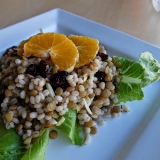
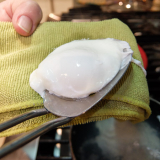
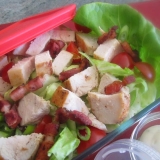
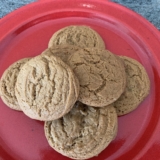
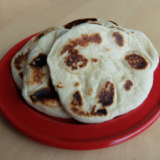
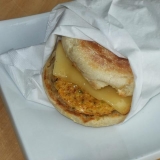
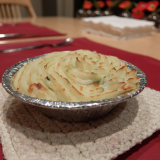
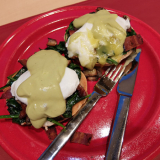
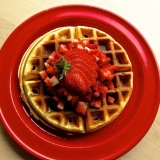
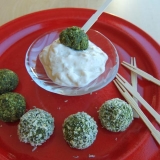

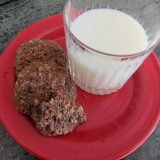
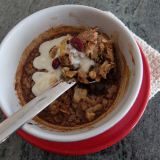
Leave A Comment